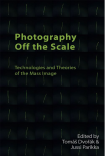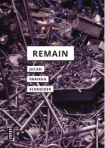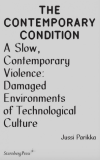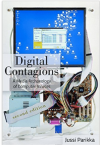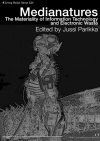Archive
On Practices of Images and Measures of Practice
Out in the new issue of Media Theory
“This conversation between Jane Birkin and Jussi Parikka picks up on two recently published books, Birkin’s Archive, Photography and the Language of Administration (Amsterdam University Press 2021) and Parikka’s co-edited Photography off the Scale (Edinburgh University Press, 2021, with Tomáš Dvorák). The conversation focuses on some of the media theoretical undercurrents of their two books that feature the photographic image as a central part of both their interests, while also shifting to different aspects of institutional practices of images, including questions of logistics of order and enumeration.”
On the Scale, Quantity, and Measure of Images
Our publisher Edinburgh University Press has kindly put online and as open access the introduction to our book Photography Off the Scale. The co-written article “On the Scale, Quantity, and Measure of Images” gives an insight to many of the key themes of the book and hopefully thus also acts as a “trailer” sample of the book itself. You can find the introduction on the webpage under “Resources“.
For those interested in buying the book, you get 30% off if you use the discount code “new30” when ordering directly through the Press’ site.
Images Beyond Control
The next in line of our Operational Images and Visual Culture project’s events at FAMU at the Academy of Performing Arts in Prague takes place on November 6th. After our previous events Photography Off the Scale and Expert-Readable Images, this one is titled Images Beyond Control. Michal Šimůnek and Josef Ledvina from our project team took the lead in developing the theme that makes reference to two key centennials closely related to Prague – the birth of Vilém Flusser, and Čapek brothers’ invention of the word robot.
You can find the program, a longer description, and the instructions on how to join on Zoom or YouTube here!

+ Thanks to Abelardo Gil-Fournier for designing the poster.
Seed, Image, Ground
The new video essay Seed, Image, Ground is the most recent example of our collaborative work with Abelardo Gil-Fournier emerging from our project on vegetal surfaces and media aesthetics. Launched today, the video was commissioned by Fotomuseum Winterthur as part of their cluster Situations/Strike. Below the introduction text and the video! Please contact me or Abelardo for any queries related to possible video installation versions of the piece.
***
Seed, Image, Ground (2020)
Seed bombing is a technique used in forestry, agriculture, and environmental restoration where biodegradable containers filled with seeds and soil nutrients are dropped from flying aircrafts to the ground. Conceived after WW2 by an RAF pilot, its use has been fostered during the last decade, linked to the increased deployment of robotic aerial vehicles in environmental monitoring.
Seed, Image, Ground works with selected promotional images and videos related to seed bombing. It combines them with footage showing the movements of seeds and leaves, and the growth of plants. The video essay concerns the link between images, seeds, aerial operations, and transformation of earth surfaces into data. It acknowledges how the history of botanic knowledge and visual surveys of green surfaces is a history of images, and how the latter is also a history of circulation, speed, and motorised aircraft. Such images operate much beyond visuality.
Seed, Image, Ground offers an alternative way of understanding “the strike.” From metaphors of war to guerrilla farming, from agricultural techniques and reforesting to the automation of airspace and environmental management, the observation of growth of vegetal surfaces unveils connections to parallel histories of the logistics of military perception.
Sound design by María Andueza Olmedo. Research for the video essay was supported by the project Operational Images and Visual Culture, situated at the department of Photography at the Academy of Performing Arts, Prague. The project is funded by Czech Science Foundation project 19-26865X.
Expert-Readable Images
Welcome to our Operational Images project event on Expert-Readable Images at the end of November in Prague at FAMU part of the Academy for Performing Arts. Please find below a short description of the event and list of invited speakers. The event is organised by Dr Tomáš Dvořák (FAMU) and myself together with the project team.

Expert-Readable Images
November 29, 2019 – FAMU in Prague
While machine-readable images have become a constant reference point for photographic theory and contemporary visual media studies, our event turns to the question: what are the specialised expert-readable image practices that cater to the technical specifics, institutional demands, and particular knowledge-roles of visual culture?
Recent discussions of operational images as well as technical media and visual cultures often invoke the distinction between human and machine vision. Automated visual systems are claimed to produce images by and for machines, pictures that are unreadable or even invisible to human eyes. Our conference seeks to complicate this dichotomy by addressing the field of professional perceptual skills, trained judgment, and expert practices of observation and instruction. Should we consider specific thought styles (to borrow a term from Ludwik Fleck) and thought collectives that develop simultaneously with the technologies of instrumental imaging and visualizing? What does a doctor see in a CT scan? What does a drone operator see on a monitor? What does a statistician see in a graph? What does a forensic analyst see in a digital model? What does a content moderator see in our holiday memories? What are the particular cultural techniques of practice, of training, and operation that govern these relations to images?
The one day day conference gathers specialists from fields of media, visual culture, photography and science and technology studies (STS) to engage with the world of specialised technical images. We shift the focus from machines to the training and governance of humans who deal with those images.
For any queries, please get in touch via email at jussi.parikka@famu.cz.
Poster design: Abelardo Gil-Fournier.
Operational Images project funding
Some news: I am happy to announce that we have won a large grant for our proposal “Operational Images and Visual Culture” with colleagues at FAMU, photography department, part of the Academy of Performing Arts, Prague. Funded by the Czech Science Academy, our research team will engage with contemporary visual culture, photographic theory and the notion of operational images that stems from Harun Farocki’s work. The project is not solely focused on Farocki but the concept of the operational – sometimes translated as operative – image becomes one of the guiding lines of inquiry that facilitates useful, interesting and alternative ways to understand media archaeology of technical images (as patterns, as measurement, as instructions etc.) and contemporary practices of photography. Automated, instructive, algorithmic, measuring and non-representational images are here part of our focus that stems from some of the discussions of past year’s of media, film and visual theory.
FAMU has a great reputation, not least as a renowned film school and I have had the pleasure of collaborating especially with Dr. Tomáš Dvořák over the past year on other projects already. Stay tuned for updates from our Operational Images project and please get in touch if you have any questions!
The Project’s FAMU website for further info.
Slow Violence – No Man’s Land
My short essay-booklet A Slow Contemporary Violence came out in 2016 in the Sternberg Press series The Contemporary Condition that is continuing in full swing. Below is a short excerpt from my contribution to the series. The excerpt is the passage on Güven İncirlioğlu’s photograph installation touching on the 100th anniversary of WWI. One can consider it still as rather apt timing, including how it speaks about the war that never ended and in its own way, continuing themes that relate to Rob Nixon’s thesis about slow violence which is also one of the reference points for my whole essay.

***
I want to address the idea of temporal conglomerations and deep times of contemporary geopolitics as slowness or long term durations that unfold as not immediate for the human perception. I want to start by way of photographic art.

Fig. 1: A close up of “Her Taraf – No Man’s Land” by Güven İncirlioğlu. Used with permission.
As part of a selection of works from the 3rd and 4th Çanakkale Biennial in Turkey,Güven İncirlioğlu’s installation piece “Her Taraf – No Man’s Land” from 2014 is one of the many art and culture commentaries about the Gallipoli campaign, also known as Dardanelles Campaign, that took place on Turkish soil during the First World War. The events have been commemorated over the past times on many occasions and by many institutions from official governments to universities to cultural institutions. The war and its relation to modern Europe and global geopolitics has multiple narratives, and for historians of media and technology, it has been marked as a turning point of the twentieth century. The war was also a mobilization of new technologies including the wristwatch and different solutions for wireless communication on the front line; the media connections were important in military operations, but they also started to enter the private sphere of the domestic life. In addition, the chemical technologies presented a more efficient way of destruction from the air both as planes and as chemical warfare, which was employed on the European front effectively; such also formed the backbone of the pesticide-enhanced agriculture of the twentieth and twenty-first century.
Many of the military operations and events took place on the outskirts of our current version of Europe, including Turkey and the Ottoman Empire. A hundred years after the war, and a hundred years after the start of the naval assault by Britain and France, on 25 April 1915, the digital photographs in the installation tell a partial historical story about what remains after the war and its devastation. The images do not, however, feature the usual iconography of human memory: of old photographs juxtaposed with other objects of memories; of faces as souvenirs of the old grainy image era transported in photography. It is a story not so much of faces but of landscapes of war and technology, of chemistry and destruction.
The photographic installation is a mini-landscape that occupies one wall. The images commemorate the First World War as an event of technological warfare of massive ecological scales. But it also becomes clear that the commemoration works in alternative ways; it is less as a celebration of the Ottoman victory than a subtle sort of a monument that entangles social history and natural history, and acts as a conglomeration of different temporal regimes. Even this distancing from the nationalist narrative is worthwhile noticing in the midst of the years of strong religiously tuned nationalist rhetoric and policy measures of current day Turkey. But the temporal politics of the images works differently. Enhanced by the atmosphere of silence surrounding the digital images placed on the walls of the Depo-gallery, İncirlioğlu’s piece is described as a commentary on the two times of “human life and the time of nature,” as the accompanying text on the wall informs. A usual historical narrative builds the memory around the 100 year milestone from the events, but the piece reminds of the multiple ways of narrating and recording time — not a passing of time, but a slow chemical sedimentation of time; it reminds how time is not merely a passing of events, but a milieu of multiple ways of accounting for it in the midst of human and non-human agents. It expresses a landscape of time, but not a landscape of the usual mastery through which we have been accustomed to think of nature in art history. It is a landscape, which we are still involved in.

Fig. 2: Installation view at Depo Gallery of “Her Taraf – No Man’s Land”. Used with permission.
The title “No Man’s Land” refers to the contested zone between the trenches that during the long months until January 1916 changed occupation many times. It brings to mind the various historical narratives of human misery that the existential non-space of the trench meant — both in terms of anxiety of waiting, the deadly warfare and also the stink of diseased bodies.
For material stories of the war, writers have addressed “bunker archaeology”5 as the architectural legacy of war that transforms into the concrete aesthetics of the Cold War that still lingers on in port and other towns bombed down during the latter of the two world wars, and replaced by Brutalist building blocks in many of their central quarters. But İncirlioğlu extends from the social and human history of ruins to what lies beneath the architectural as its ground, the soil and the seabed. His photographic installation talks of the invisible chemical traces of dead bodies, body parts, barbed wired, gun shells, mines, dead trees, and flora — a natural history of the intensity of the war localized back then in Çanakkale but one that seems in its own way planetary. The geopolitical aim of landing through Çanakkale to reach Istanbul never succeeded according to the plans, but the geophysical legacy of such warfare in the age of advanced machinery left its concrete trace in the soil. İncirlioğlu’s meditation is not, however, only about that particular piece of land, the landing site and its territories formed of trenches, blue waters giving way to the war ships that connected to the supply routes, distant ports in England and other places, and many other operations; it also includes a global perspective.
He continues by way of a short biospheric meditation of technical war: “Today, it is possible to say that the global state of war that also encompasses the biosphere has been going on for a century.”6 İncirlioğlu continues referring to the annihilation of masses in the Middle East, Africa, Asia — an extension of the continued war; on the other, the “total destruction of human habitats, rivers, forests and the biological-mineral world is being processed on by the neo-liberal policies worldwide. In this context, today’s Istanbul’s northern forests, quarries, African gold mines, vast territories of fracking in Canada and all other sites of destruction [……] resemble the scene of a ‘no man’s land’.”7
The story told was not after all a commemoration of a war that ended but the war that never ended ; the war that facilitated an entry of new sorts of technical forms of control, regulation, production of chemicals and more — an apt theme considering we are living in a sort of a continuous Cold War8 defined by territorial claims, energy wars, realpolitik of terrorism entangled with geopolitics, movements of biomass that expresses itself as the human suffering of forced refugee movements. Beginnings and endings become only temporary markers for narratives that are insufficient for the complexity of this time. The sort of a war we are addressing does not lend itself to easy stories of ideological oppositions but to complex networks, which entangle strategies and tactics with environmental realities and the finitude of the world of energy and materials. These sorts of wars are geopolitical in the fundamental sense, and do not involve just the two sides of troops in trenches. Indeed, it moves the focus from the human actors, soldiers, tragedies of personal, family and other scales to those of soil, the ground, the air — an elemental tragedy that is the backdrop in which a drama of the Anthropocene might unfold. It is also a tragedy that comes out clearest in its slowness.


